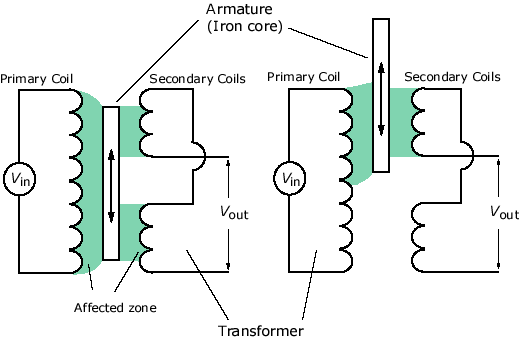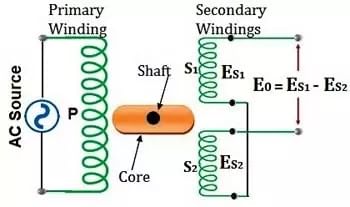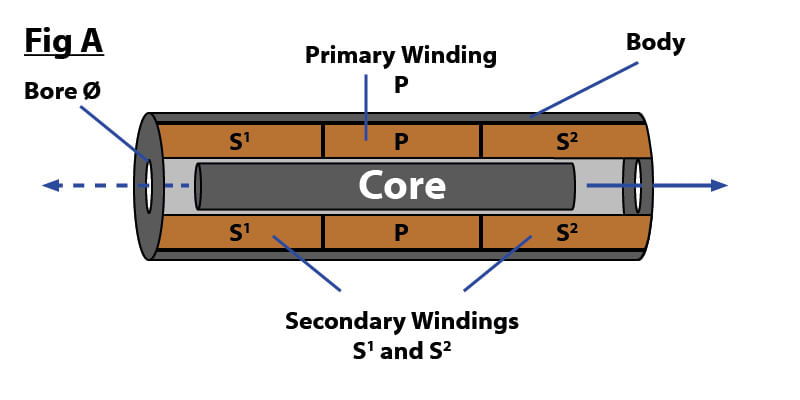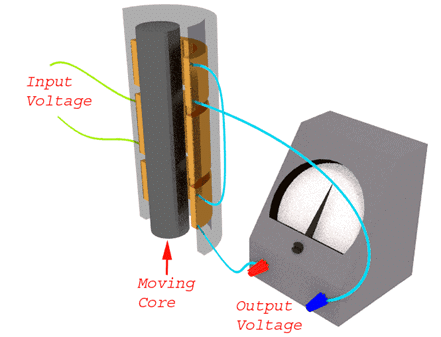LVDT: Detailed Notes | Sensor & Industrial Instrumentation - Electronics and Communication Engineering (ECE) PDF Download
Definition of LVDT
The term LVDT stands for the Linear Variable Differential Transformer. It is the most widely used inductive transducer that converts the linear motion into the electrical signal.
The output across secondary of this transformer is the differential thus it is called so. It is very accurate inductive transducer as compared to other inductive transducers.
➢ Construction of LVDT
Main Features of Construction:
- The transformer consists of a primary winding P and two secondary windings S1 and S2 wound on a cylindrical former (which is hollow in nature and contains the core).
- Both the secondary windings have an equal number of turns, and we place them on either side of primary winding.
- The primary winding is connected to an AC source which produces a flux in the air gap and voltages are induced in secondary windings.
- A movable soft iron core is placed inside the former and displacement to be measured is connected to the iron core.
- The iron core is generally of high permeability which helps in reducing harmonics and high sensitivity of LVDT.
- The LVDT is placed inside a stainless steel housing because it will provide electrostatic and electromagnetic shielding.
- The both the secondary windings are connected in such a way that resulted output is the difference between the voltages of two windings.
➢ Principle of Operation and Working
As the primary is connected to an AC source so alternating current and voltages are produced in the secondary of the LVDT. The output in secondary S1 is e1 and in the secondary S2 is e2. So the differential output is,
eout = e1 - e2
This equation explains the principle of Operation of LVDT: Now three cases arise according to the locations of core which explains the working of LVDT are discussed below as,
Now three cases arise according to the locations of core which explains the working of LVDT are discussed below as,
- CASE I: When the core is at null position (for no displacement) When the core is at null position then the flux linking with both the secondary windings is equal so the induced emf is equal in both the windings. So for no displacement the value of output eout is zero as e1 and e2 both are equal. So it shows that no displacement took place.
- CASE II: When the core is moved to upward of null position (For displacement to the upward of reference point) In the this case the flux linking with secondary winding S1 is more as compared to flux linking with S2. Due to this e1 will be more as that of e2. Due to this output voltage eout is positive.
- CASE III: When the core is moved to downward of Null position (for displacement to the downward of the reference point). In this case magnitude of e2 will be more as that of e1. Due to this output eout will be negative and shows the output to downward of the reference point.
Output VS Core Displacement A linear curve shows that output voltage varies linearly with displacement of core. Some important points about magnitude and sign of voltage induced in LVDT:
Some important points about magnitude and sign of voltage induced in LVDT:
- The amount of change in voltage either negative or positive is proportional to the amount of movement of core and indicates amount of linear motion.
- By noting the output voltage increasing or decreasing the direction of motion can be determined.
- The output voltage of an LVDT is linear function of core displacement.
➢ Advantages of LVDT
- High Range: The LVDTs have a very high range for measurement of displacement. They can used for measurement of displacements ranging from 1.25 mm to 250 mm
- No Frictional Losses: As the core moves inside a hollow former so there is no loss of displacement input as frictional loss so it makes LVDT as very accurate device.
- High Input and High Sensitivity: The output of LVDT is so high that it doesn’t need any amplification. The transducer posseses a high sensitivity which is typically about 40V/mm.
- Low Hysteresis: LVDTs show a low hysteresis and hence repeatability is excellent under all conditions.
- Low Power Consumption: The power is about 1W which is very as compared to other transducers.
- Direct Conversion to Electrical Signals: They convert the linear displacement to electrical voltage which are easy to process
➢ Disadvantages of LVDT
- LVDT is sensitive to stray magnetic fields so it always requires a setup to protect them from stray magnetic fields.
- LVDT gets affected by vibrations and temperature.
➢ Applications of LVDT
- We use LVDT in the applications where displacements to be measured are ranging from a fraction of mm to few cms. The LVDT acting as a primary transducer converts the displacement to electrical signal directly.
- The LVDT can also act as a secondary transducer. E.g. the Bourbon tube which acts as a primary transducer and it converts pressure into linear displacement and then LVDT coverts this displacement into an electrical signal which after calibration gives the readings of the pressure of fluid.

|
26 videos|28 docs|29 tests
|
















